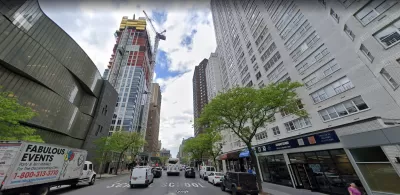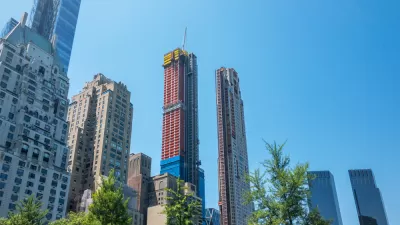The new skyscraper being built at 200 Amsterdam Avenue in Manhattan might be forced by an appeals court to remove 20 floors of the mostly complete building.

"Now that the 52-story tower at 200 Amsterdam Avenue is almost done, it may soon have to be partly undone, like a construction film running in reverse," writes Justin Davidson.
The building's final height is subject to a case currently underway in appeals court, with as many as 20 stories, already mostly built, hanging in the balance.
All of the confusion, according to Davidson, is thanks to New York's inscrutable zoning code, and the building's location on a "bizarre knot" of parcels.
Complexity favors developers equipped with expensive legal advice, which is how SJP Properties persuaded the Department of Buildings to issue a permit for a 668-foot spear sticking into the flank of the Upper West Side. The narrow, stretched-out tower designed by Elkus Manfredi reaches its kinda–sorta–neo–Art Deco–ish crown via a series of setbacks that make it look like a staircase in the wrong aspect ratio. Any tall building can unleash the usual It’s out of character! versus More housing now! shoutfest, but this one has turned area residents into self-appointed land-use experts.
As detailed in the history provided here by Davidson, the unbuilding of skyscrapers happens with some frequency in New York, and this wouldn't be the first time a building has had to lop its top off. That's where those with even a passing interest in the science and art of building might be interested in this case study. "In a city too packed for implosion or wrecking balls, disassembling an entire structure is slow and dangerous work, planned by specialized engineers," according to Davidson.
FULL STORY: How Do You Chop 20 Stories Off a Too-Tall Building?

Trump Administration Could Effectively End Housing Voucher Program
Federal officials are eyeing major cuts to the Section 8 program that helps millions of low-income households pay rent.

Planetizen Federal Action Tracker
A weekly monitor of how Trump’s orders and actions are impacting planners and planning in America.

Ken Jennings Launches Transit Web Series
The Jeopardy champ wants you to ride public transit.

Congress Moves to End Reconnecting Communities and Related Grants
The House Transportation and Infrastructure Committee moved to rescind funding for the Neighborhood Equity and Access program, which funds highway removals, freeway caps, transit projects, pedestrian infrastructure, and more.

From Throughway to Public Space: Taking Back the American Street
How the Covid-19 pandemic taught us new ways to reclaim city streets from cars.

Opinion: Transit Agencies Must View Service Cuts as Last Resort
Reducing service could cripple transit systems by pushing more riders to consider car ownership, making future recovery even less certain.
Urban Design for Planners 1: Software Tools
This six-course series explores essential urban design concepts using open source software and equips planners with the tools they need to participate fully in the urban design process.
Planning for Universal Design
Learn the tools for implementing Universal Design in planning regulations.
Heyer Gruel & Associates PA
Ada County Highway District
Institute for Housing and Urban Development Studies (IHS)
City of Grandview
Harvard GSD Executive Education
Toledo-Lucas County Plan Commissions
Salt Lake City
NYU Wagner Graduate School of Public Service





























